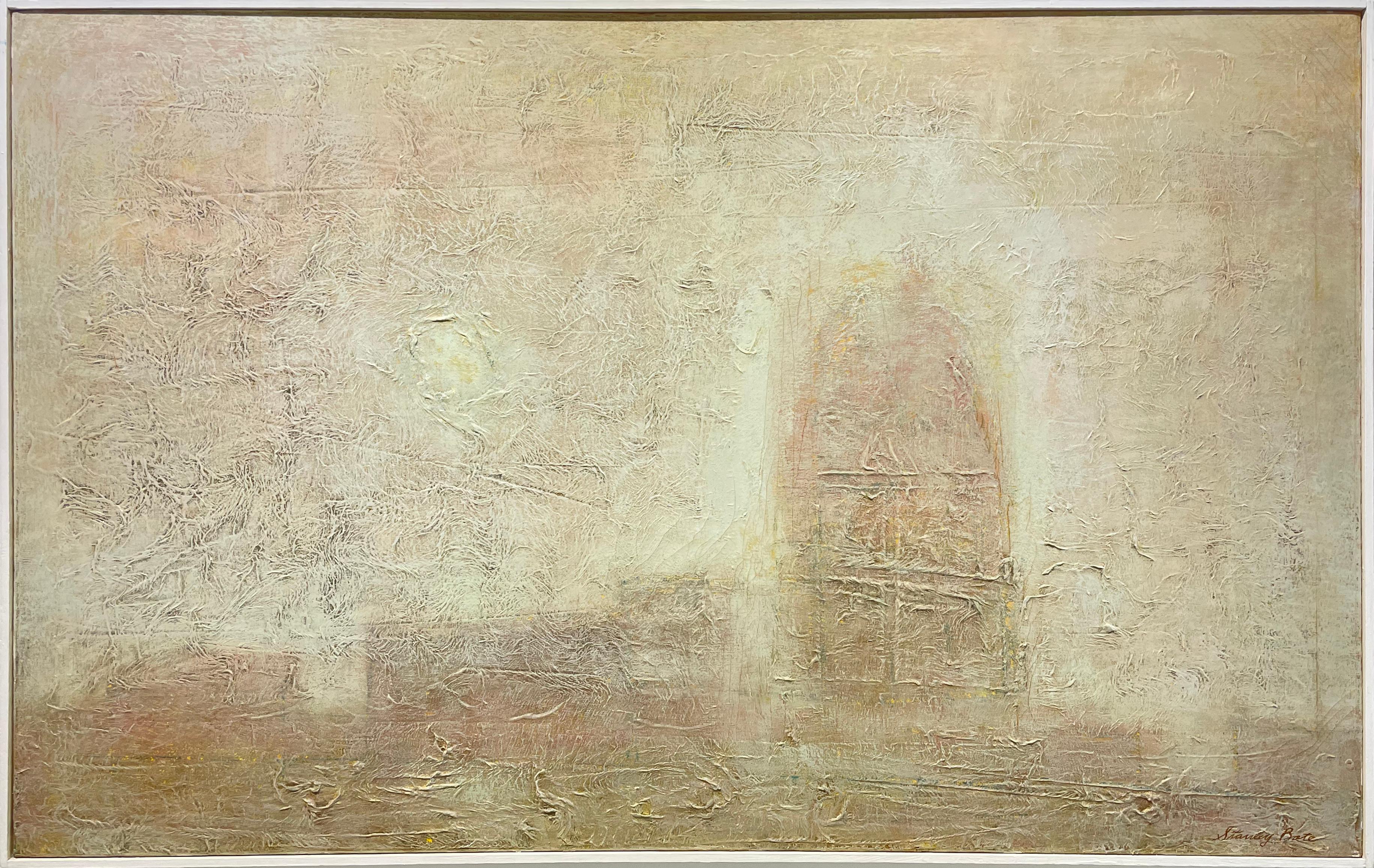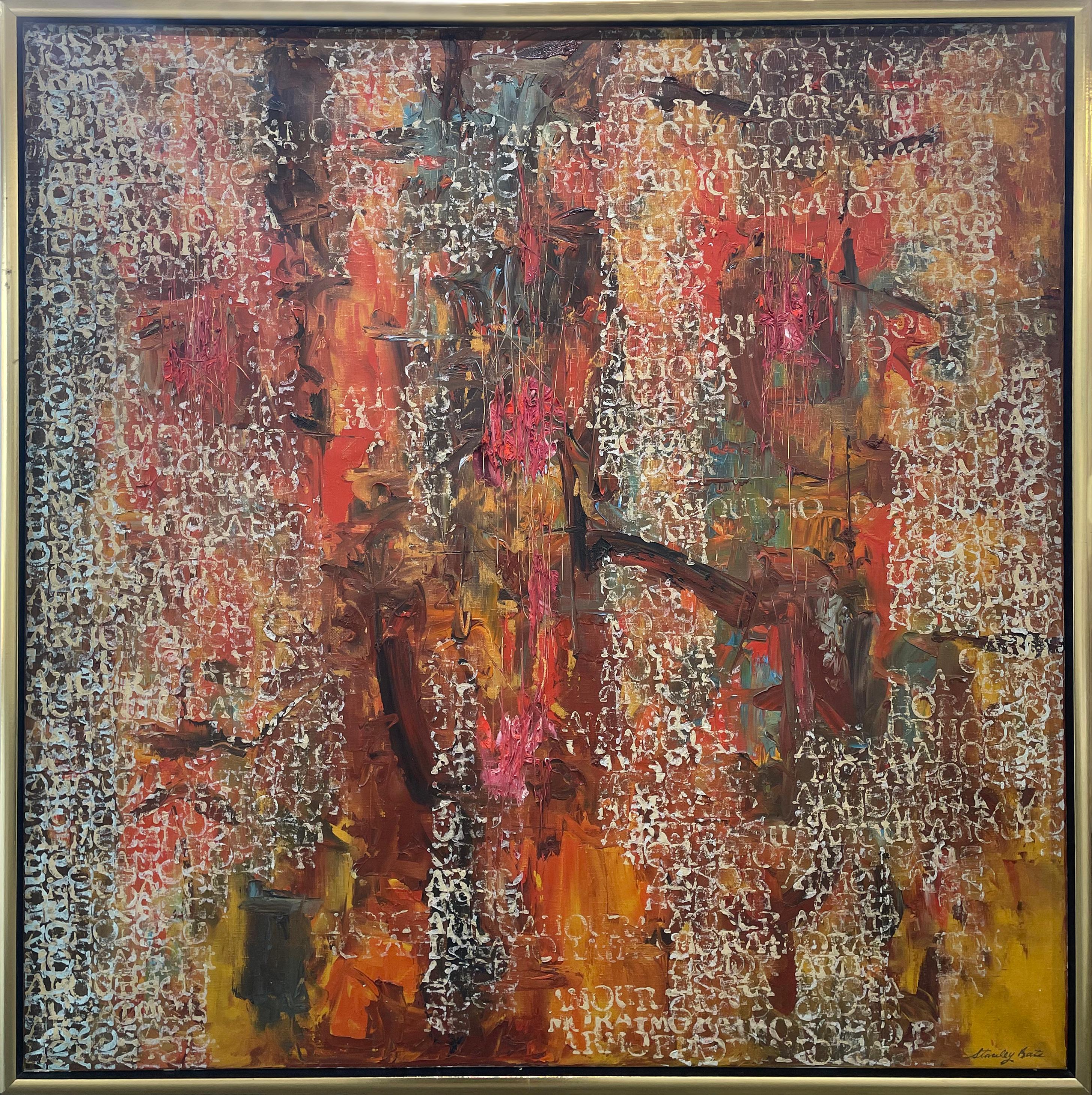Stanley Bate« Rues d'Athènes », peinture abstraite moderne des années 1960C. 1960
C. 1960
À propos de cet article
- Créateur:Stanley Bate (1903 - 1972, Américain)
- Année de création:C. 1960
- Dimensions:Hauteur : 78,74 cm (31 po)Largeur : 109,86 cm (43,25 po)Profondeur : 4,45 cm (1,75 po)
- Support:
- Mouvement et style:
- Période:
- État:Signed by artist. Professionally framed.
- Adresse de la galerie:Westport, CT
- Numéro de référence:
Stanley Bate
Stanley Bate est né le 26 mars 1903 à Nashville, dans le Tennessee, de Henry C.C. et Nellie E. Freeman Bate. Les Bates étaient une famille établie du Tennessee. Le frère de Henry, William Bate, a été gouverneur du Tennessee de 1883 à 1987 et sénateur des États-Unis de 1887 à 1905. William était également général de division dans l'armée confédérée pendant la guerre de Sécession et un personnage haut en couleur. Henry et Nellie encouragent leur fils à suivre une éducation formelle, mais le jeune Stanley renonce à une véritable scolarité et choisit plutôt d'étudier l'art à l'Institut Watkins de Nashville. Dans les années 20, Bate s'installe à New York pour étudier à l'Art Students League sous la direction de Frederick Bridgman. Il a rapidement trouvé un emploi à l'Encyclopedia Britannica et, de 1927 à 1929, a occupé le poste de rédacteur artistique.
De 1929 jusqu'à sa mort en 1972, Bate a été un artiste indépendant. Il a donné des cours d'art à l'Art Students League et à l'Albany Institute of History and Art et a obtenu des revenus supplémentaires en réalisant des illustrations pour des magazines tels que Outdoor Life et Popular Science. Le 27 janvier 1934, Bate épouse Emilie Rossel. Emilie avait émigré de Suisse à New York en 1923. Elle a travaillé comme gouvernante pour Alfred Vanderbilt, puis comme secrétaire de direction pour Kahn, Loeb and Co, une société de courtage en valeurs mobilières de Wall Street. Emilie a rencontré Stanley à New York au début des années 30, lorsqu'elle a assisté à l'une de ses expositions d'art avec un ami. Le couple, qui n'avait pas d'enfant, vivait sur la 34e rue à Manhattan. Pendant cette période, Bate produit et expose ses œuvres et rejoint plusieurs groupes d'artistes. Stanley et Emilie font partie de la scène artistique new-yorkaise, dînant chaque semaine au Society of Illustrators Clubhouse. Le séjour de Bate à New York a été déterminant pour la formation de son style de peinture. Il a vécu à New York pendant la création de l'un des plus importants mouvements d'art moderne, qui a permis à New York de remplacer Paris en tant que centre de l'art d'avant-garde. Ce mouvement, qui s'appelait la New York School of Artists, fut plus tard connu sous le nom d'expressionnisme abstrait. Elle était composée d'un groupe d'artistes d'avant-garde vaguement associés, travaillant à New York dans les années 40 et 50. L'école de New York n'était pas définie par un style spécifique, mais reflétait plutôt une fusion du modernisme européen et de la pertinence sociale américaine qui était représentée dans de nombreux styles individuels. Les influences du surréalisme, du cubisme et du modernisme se retrouvent dans leur travail, ainsi qu'un intérêt pour l'expérimentation de matériaux et de méthodes non traditionnels. Pour la première fois, l'art américain est à la pointe de l'avant-garde internationale.
Bate a sans aucun doute été exposé aux divers styles et techniques qui émergeaient pendant les années de formation de l'école de New York. Mark Rothko et Robert Motherwell élaborent leurs versions des peintures de champs de couleurs. Joseph Cornell expérimente les assemblages, les collages et l'utilisation de différents types de peintures texturées. Jackson Pollock collait des objets tels que des boutons et des pièces de monnaie dans ses premières œuvres, tandis que Louise Nevelson utilisait des objets trouvés. Helen Frankenthaler ajoute du sable à ses premières peintures. Les artistes de l'école de New York ébranlaient les beaux-arts traditionnels en utilisant des techniques mixtes et des méthodes non traditionnelles. Bate absorbe ces diverses influences et bientôt ses premiers paysages et natures mortes réalistes sont remplacés par quelque chose d'entièrement nouveau. L'influence du cubisme, notamment l'espace plat et peu profond du plan de l'image, est évidente dans nombre de ses peintures. Le surréalisme est évident dans l'utilisation de sujets tirés des mythes, de l'art primitif et de l'antiquité, ainsi que dans le travail au trait, proche de l'automatisme, de ses images plus linéaires. L'expérimentation débridée de l'école de New York est omniprésente dans l'œuvre de Stanley. On y trouve des clins d'œil au champ chromatique, au collage, au mélange de textures dans la peinture, aux techniques mixtes, à l'inclusion d'objets trouvés et à des empâtements épais et luxuriants. Il a été prolifique et a expérimenté divers médias, notamment l'huile, l'aquarelle, la lithographie, la sérigraphie, la gravure sur bois, le dessin, le collage, la céramique et la sculpture. Il est considéré comme un véritable moderniste. Son travail est en grande partie abstrait, mais des figures et des bâtiments sont parfois discernables. Il mélangeait souvent de la peinture, du sable et de la colle pour obtenir une surface texturée, puis il grattait cette couche pour exposer une partie de la peinture sous-jacente. Sa sculpture, souvent fantaisiste, reflète également les méthodes non traditionnelles de l'école de New York. Il a été le premier à utiliser l'émail et le cuivre dans son travail. Les sculptures ne sont pas taillées ou modelées comme par le passé, mais construites à l'aide de techniques mixtes et de nouveaux matériaux.
Outre l'influence de l'école de New York, nombre de ses œuvres présentent un lien étroit avec l'école espagnole, en particulier les travaux d'Antonio Tapies et de Modesto Cuixart. Ces artistes faisaient tous deux partie d'un groupe d'avant-garde connu sous le nom d'Art Informel, l'équivalent espagnol de l'expressionnisme abstrait. Ces artistes ont également travaillé avec des techniques mixtes et ont introduit des objets et des textures dans leurs œuvres. De nombreux sujets et titres de Bate se rapportent à des lieux et à des mots espagnols. Il est probable que Stanley ait passé du temps en Espagne et y ait trouvé l'inspiration. Au début des années 40, Stanley et Emilie ont commencé à passer des week-ends dans une grange qu'ils ont achetée à Craryville, dans l'État de New York, à quelques heures au nord de Manhattan. La grange n'avait ni électricité ni plomberie, mais lorsque le couple a décidé de quitter New York et de vivre à plein temps à Craryville, il a réaménagé la grange, installant une galerie au rez-de-chaussée et un studio et un logement à l'étage. Bien que les Bates aient quitté la ville de New York, Stanley est resté sur la scène artistique new-yorkaise, exposant à New York et ailleurs tout au long des années 50 et 60. De son vivant, il a été représenté par les galeries new-yorkaises Knoedler and Company, Kennedy Galleries, Rose Fried Gallery et Key Gallery, ainsi que par la Tyringham Gallery située à Tyringham, dans le Massachusetts. Stanley a vécu à Craryville jusqu'à sa mort, le 21 août 1972. Emilie est décédée en 1984. Dans sa notice nécrologique, elle demande que les dons éventuels soient versés à l'Institut d'histoire et d'art d'Albany. L'Institut a organisé une exposition rétrospective de l'œuvre de Bate en 1973. Depuis sa mort, les œuvres de Bate ont fait l'objet de nombreuses expositions et sont entrées dans de nombreuses collections.
- ExpéditionRecherche du devis...Expédition à partir de : Albany, NY
- Politique des retoursCet article ne peut pas être retourné.
- "Rites of Spring", Peinture abstraite moderne des années 1970Par Stanley Bate"Rites du printemps" du peintre moderniste Stanley Bate est une peinture à l'huile sur toile à grande échelle et texturée. Les couleurs gris foncé et marron servent de toile de fond ...Catégorie
années 1970, Moderne, Peintures - Abstrait
MatériauxToile, Huile
- « Great Wall, » peinture abstraite moderne des années 1970Par Stanley BateCette peinture à l'huile abstraite moderne sur toile de l'artiste moderniste Stanley Bate présente une composition géométrique et une palette douce. Les couleurs blanche et crème son...Catégorie
années 1960, Moderne, Peintures - Abstrait
MatériauxToile, Huile
- "Morat", Peinture abstraite moderne des années 1960Par Stanley BateCette peinture abstraite de l'artiste moderniste Stanley Bate combine un rouge profond et texturé avec du bleu crème et du gris foncé. Les formes géométriques du tableau sont adoucie...Catégorie
années 1960, Moderne, Peintures - Abstrait
MatériauxToile, Huile
- Peinture abstraite moderne des années 1960 « cathédrale »Par Stanley BateCette peinture abstraite moderne de Stanley Bate présente une palette de beige clair, de crème et de sépia chaud. La peinture texturée présente des formes plus sombres qui courent su...Catégorie
années 1960, Moderne, Peintures - Abstrait
MatériauxToile, Huile
- Peinture abstraite moderne des années 1960 « Mazarn »Par Stanley BateDans cette peinture abstraite moderne de Stanley Bate, une palette audacieuse est mariée à des formes imparfaites et à de larges coups de pinceau. Des rectangles beige sable se mêlen...Catégorie
années 1960, Moderne, Peintures - Abstrait
MatériauxToile, Huile
- Peinture abstraite moderne des années 1960 « Messages to Fribourg »Par Stanley BateThis Modern abstract painting by Stanley Bate features a warm, deep palette of red, yellow, orange, and burnt umber. Thick strokes of paint are layered beneath light white overlappin...Catégorie
années 1960, Moderne, Peintures - Abstrait
MatériauxToile, Huile
- Grande échelle carrée et circulaire moderniste abstraitMerveilleux tableau abstrait de grande taille, aux tons naturels, comprenant un rectangle de blanc antique texturé avec un sac de chanvre gesso et placé au-dessus d'un second rectang...Catégorie
années 1980, Moderne, Peintures - Abstrait
MatériauxGesso, Toile, Huile
- Sans titrePar Peter StroudHuile sur toile. En très bon état avec des couleurs vives. Provenance : Manufacturers Hanover Trust Company, New York, avec l'étiquette au verso ; collection privée, New York.Catégorie
années 1960, Moderne, Peintures - Abstrait
MatériauxToile, Huile
- Improvisations sur un thème de Chagall n° 1 - Alan Davie, peinture, moderne, britanniquePar Alan DavieAlan Davie (1920-2014) Improvisations sur un thème de Chagall n° 1 1 Décembre 1966 huile sur toile 213 x 172,5 cm signé, daté et titré (au verso) Prix : 95 000 GBP Provenance : Gal...Catégorie
années 1960, Moderne, Peintures - Abstrait
MatériauxToile, Huile
- La reine Emma - Alan Davie, peinture, moderne, britannique, grande, colorée, couleursPar Alan DavieAlan Davie (1920-2014) Reine Emma Juin 1968 huile sur toile (triptyque) 213.5 x 404 cm signé, daté et titré (au verso) Prix : 300 000 GBP (TVA britannique de 20 % incluse) Provenan...Catégorie
années 1960, Moderne, Peintures - Abstrait
MatériauxToile, Huile
- Sans titrePar Louisa ChaseLouisa Lizbeth Chase est née en 1951 de Benjamin et Wilda Stengel Chase à Panama City, au Panama, où son père, diplômé de West Point, était en poste. La famille s'est installée en Pe...Catégorie
20ième siècle, Modernisme américain, Peintures - Abstrait
MatériauxToile, Cire, Huile
- Sans titre (bateau)Par Louisa ChaseLouisa Lizbeth Chase est née en 1951 de Benjamin et Wilda Stengel Chase à Panama City, au Panama, où son père, diplômé de West Point, était en poste. La famille s'est installée en Pe...Catégorie
20ième siècle, Moderne, Peintures - Abstrait
MatériauxToile, Huile






